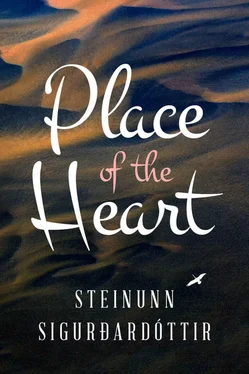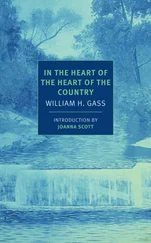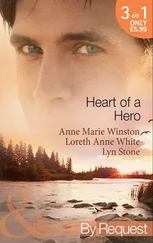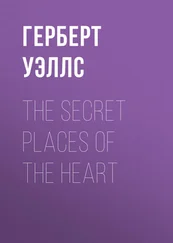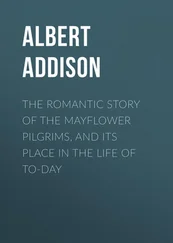The dance of lovers. A brilliantly coordinated pas de deux, as if performed by the most accomplished of ballet artists.
In my winter lair I’ll program dreams about THE DANCE OF LOVERS AND SIDE ROADS OF THE EASTFJORDS.
I’m curious about that closed book: a hidden world within fjords that concerns me, where my people endured through rock-hard centuries. I’ve never explored a single road that heads inland from the fjord, winding up a hill, onto a heath. To cut between fjords, behind the mountains, is a future dream, as is Cherry Square in Perpignan. Where Harpa Eir wouldn’t stand out, wearing a white T-shirt and sunglasses, drinking espresso from a tiny cup and water from a glass, beneath a striped umbrella.
In the spring, when the roads are turned muddy from melting snow, I’ll use the last drops of power in the Israeli Willys to drive along tracks leading deep into the fjord, and then up to the high heath, to the next fjord, see the view change markedly with each passing yard, with each little twist, with each turn, a new landscape with new angles and indentations and curves, drastically changing mountains.
This spring I’m going to travel, Heiður, I announce. Even if I have to go alone in that junky jeep.
If I’m free, little one, I’ll come in the pickup and we’ll travel in style. Champagne in coolers — that’s what I call traveling. You never know, I might just bring Dietrich along.
But we have no use for him.
Maybe you don’t.
Through the back of my head, I see the yellow cat eyes in the backseat burning with suppressed malice, and I feel them burning two points into my scalp.
Edda envies us because we enjoy traveling together. That’s life. Those who don’t care to do anything envy those who do care to do things. But who would possibly travel with Edda? She has no one. Those who have traveling partners should be thankful and remember that many people never travel because they have no one to travel with.
I’ll take you at your word, I say to Heiður. Come east and we’ll have a romp through the area. We’ll only walk over gentle terrain in good weather. And no camping. I’m not sleeping in a tent. I have my limits.
Heiður laughs, with whooping-cough-like wheezes.
Laugh it up. I’ll besiege you when you take a break in between concerts and trips abroad. Then we’ll journey on side roads, along zigzag paths, and discover new dells and pretty little creeks. We’ll find remarkable rocks in new landslides, gather cuckooflowers and buttercups, the brightest flowers at the very start of summer, the season that never meets the need of an Icelander for summertime bliss. This season represents fear and desire, fear of rejection, fear that this precious time will be taken from us before it’s hardly begun to take flight. But that’s in fact what happens. It’s taken from us just when we long most passionately for more. The Icelandic seasons should be named FEAR and LONGING. Summer is fear of winter; winter is longing for summer. Spring and fall don’t exist in Iceland. They’re part of winter.
The warm sea is greenish blue, like ignimbrite, and above it the scree is volcanic red, the sands of the beaches the same color. Red beach sand, the hottest colored of all the sands in the world, although the sand is in fact cold. Colors in cold countries are hotter than the things they color, hotter than the air. It’s in style with the landscape, alluring in places, but actually useless other than to look at through car windows. Landscape that’s unfarmable for anything resembling actual farming, useless for walking in except by those who wish to wander wind-dried in a rocky desert, stumbling their way up scree that’s rushing in the opposite direction.
The word ambivalent is an imperfect word that doesn’t describe how it’s possible to have a variety of stances toward things. The word ambivalent is a coarse simplification of the complex feelings toward others that toss and turn inside people, toward their native country, toward all that is.
At the foot of a steep cliff standing at a perfect right angle to the ground is a hidden house, its roof just barely visible behind trees. I should ask Heiður to stop, get out, knock on the door, and tell the people that I’m here to stay. That I’ll be taking over the house after their time. These exemplary people have cultivated tall, stocky, exemplary trees that are worthy of them in every respect. Evergreen trees to look at in the winter. Deciduous trees for the Icelandic summer, which is, I have to admit, longer than one month, considering that at that time of year the day lasts an entire twenty-four hours, round and round.
Rising from steamy veils, Iceland’s Egyptian pyramid, Búlandstindur Peak, marks the most beautiful village in the country. Nowhere in Iceland is there more drizzly fog than here in its most beautiful spot. It’s inside out, and completely in keeping with the behavior of this country.
I can’t help it that the Eastfjords are my fjords, my country, and that’s where I’ve come . I don’t just love my own fjord — the entire region is Harpa’s adventureland, which has bobbed underfoot and burned my eyes in my dreams ever since I was tiny. The people here are different, as is the climate. It’s a fantastic world. There’s more foreign blood in people of the Eastfjords than in other Icelanders. It can be seen in their external appearance, but they also stand out spiritually, though that’s a quality I’m unable to put into words.
God, it’s beautiful here, says Heiður.
This is nothing, I say. To arrive at Djúpivogur by sea at five o’clock on a spring morning — that’s something. It’s how I arrived almost every single spring that God gave me in my childhood. The pyramid appeared in the refreshing light, unless the Eastfjords fog was teasing us. But the fog made it fun, too, even though it isn’t lively by nature. Mysterious fun — elves sprang from the fog belts around the cliffs and ridges. It wasn’t possible to land, so everything was ferried by boat, piece by piece, people to shore, wares out to the ship. Sometimes the thick fog filled the fjord, making the world a white mass, concealing people and boats. But you could hear the oars striking the sea’s surface, people talking, seabirds screeching, curlews warbling, eider ducks cooing, and plovers trilling, mingled with a soft bleating.
After coming all the way east, I’d prepare a floating outdoor festival in the style of the Workers’ Weekend celebrations and fill the fjord with sails. I imitated Grandma Una in counting fifty-six sails in the fjord. I was going to sail away on all the fishing smacks, one after another. Remember the poem?
The sails on the smacks are wings of migratory birds.
Wings for sailing between sea and sky.
A sunstone points the way.
In my romantic musings I gave a novel the title THE MERMAID AND THE SEA. It began like this: So passionately did the young girl love the sea that she’d likely been a mermaid in a past life.
On the first trip, Mom and I got a ride from the pier on a tractor. Mom and I were close friends then, but it’s actually before I can remember. The next time we were picked up in a jeep without a windshield. Yet most often, Aunt Dýrfinna gave us a lift in the Israeli Willys. A few such cars, which had been lengthened or something in Israel, made their way to this country. It’s apparently the same age as I am, and I can have it, you see, though it would be a shame to stir it from its bedridden state. It hasn’t been moved for a whole year. Dýrfinna stopped driving it then, though it might have been better if she’d done so earlier, if I understand Ingólfur correctly.
It’s really making me tingle, seeing all the glory of your fjord, says Heiður. I can’t believe that I’ve never come this way before.
Читать дальше
